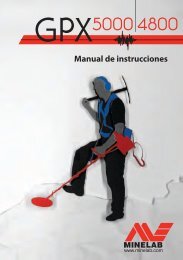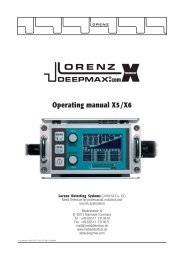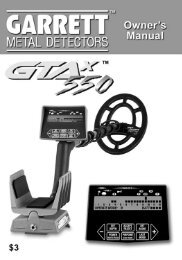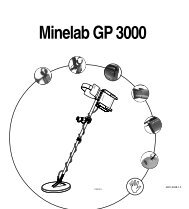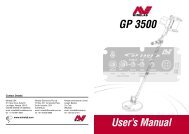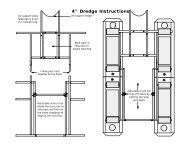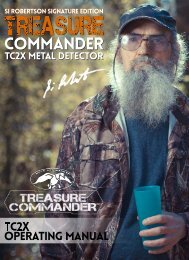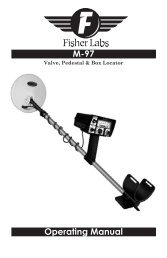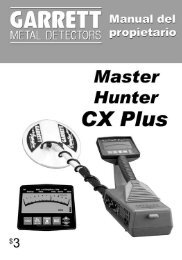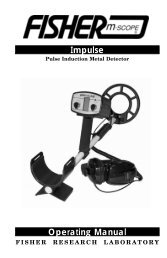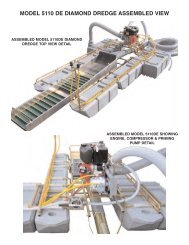Freedom 3 - Garrett
Freedom 3 - Garrett
Freedom 3 - Garrett
You also want an ePaper? Increase the reach of your titles
YUMPU automatically turns print PDFs into web optimized ePapers that Google loves.
OPERATING INSTRUCTIONS:<br />
FREEDOM 3 DETECTORS<br />
(Coin Commander, CDC, and Plus)<br />
The control panel of the <strong>Freedom</strong> 3 has four control knobs and a jack for the headphones.<br />
CONTROL FUNCTIONS<br />
Power/Detection Depth Control: Rotate knob clockwise to turn detector on. Further rotation<br />
increases detection depth.<br />
Audio Control: This enables the operator to adjust precisely the threshold level of sound<br />
generated by the detector.<br />
Dual Discrimination Controls:<br />
Ferrous Range: This knob (lower) allows adjustment for the elimination of targets in the iron<br />
range up to but not including aluminum pulltabs. Targets located and accepted in this range<br />
will give an audio increase.<br />
Non-ferrous Range: This knob (upper) allows adjustment for the elimination of targets in the<br />
range of pulltabs through aluminum screwcaps. All targets located and accepted in this range<br />
will give the coin alert audio signal.<br />
Pinpointing Trigger: This switch under the forward part of the armrest where the “trigger<br />
finger” would normally rest selects the electronic zero motion pinpointing mode. Depress and<br />
hold this switch for pinpointing.<br />
Headphone Jack: Located on the control panel.<br />
OPERATING INSTRUCTIONS:<br />
Set controls to INITIAL SETTINGS (∆) positions. By first rotating the controls to these points<br />
the detector is turned on and adjusted for satisfactory operation. Setting the audio level is a<br />
separate adjustment.<br />
Discrimination:<br />
The Trash Elimination controls permit the selection of targets desired in both ferrous and<br />
non-ferrous ranges. The Ferrous control is adjustable from zero through bottlecaps rejection<br />
while the Non-ferrous control takes over at pulltab rejection and is adjustable through<br />
aluminum screwcaps.<br />
When a metallic object is accepted, the detector’s speaker or earphone sound will increase<br />
from the pre-selected audio threshold level. When a metal object is eliminated (rejected), the
sound may decrease or become silent. Some rejected targets will cause the audio to “break<br />
up” or sound erratic. .<br />
Searching:<br />
Scan the searchcoil at a rate of about one or two feet per second. Maintain a one to two inch<br />
searchcoil height above the ground. Detection of a metal target within the ranges selected will<br />
be indicated by an increase in sound for the ferrous range and the coin alert in the non-ferrous<br />
range.<br />
Pinpointing:<br />
Precise pinpointing is available with the Pinpointing Trigger.<br />
To use the pinpointing function of the detector to determine the exact location, press the<br />
“trigger switch” and HOLD. The detector will now give a more pronounced signal when the<br />
searchcoil is held directly above or criss-crossed over the target.<br />
Even more precise pinpointing can be obtained by placing the searchcoil on the ground, then<br />
pressing and HOLDING the switch. Slide the coil, maintaining ground contact across the<br />
target.<br />
BATTERIES:<br />
The <strong>Freedom</strong> 3 requires three (3) 9-volt batteries.<br />
Battery Test:<br />
Each time the detector is turned on the batteries are automatically and audibly checked. Three<br />
tones indicate the batteries are very good, two tones and the batteries are adequate. One<br />
single tone and it is time to replace the batteries.<br />
Battery Replacement:<br />
<strong>Freedom</strong> 3 Coin Commander:<br />
The batteries are located beneath the armrest of the <strong>Freedom</strong> 3 Coin Commander. To<br />
replace them, loosen the captive metal knurled screw and remove the cover. Pull the printed<br />
circuit board with the two batteries attached from the compartment. (Notice how the wires are<br />
positioned). Next, grasp the wires on the left side of the compartment and remove the third<br />
battery. Replace the batteries being careful that the wiring follows the batteries back into the<br />
compartment.<br />
Be sure the waterproof O-ring seal is properly formed around the ridge on the cover.<br />
Reposition the door and tighten the knurled metal screw. Tighten finger tight only.<br />
<strong>Freedom</strong> 3 CDC and Plus:<br />
The batteries are located on the side of the chassis of these <strong>Freedom</strong> 3’s inside the control<br />
housing. To reach them disconnect the searchcoil cable and loosen the captive thumbscrew<br />
beneath the control housing. Press on the searchcoil connector to loosen the chassis and
carefully slide it out. The batteries are beneath a protective clamp directly behind the control<br />
panel. Loosen the screw holding it and slide the clamp off to allow removal of the batteries.<br />
MAINTENANCE<br />
Always remember that your detector is a sensitive electronic instrument. It is built to<br />
withstand rugged treatment in the outdoors. Use your <strong>Garrett</strong> detector to the fullest extent<br />
possible, and never feel that you have to baby it. Yet, always protect the detector and<br />
handle it with reasonable care.<br />
Try to avoid temperature extremes as much as possible, such as storing the detector in an<br />
automobile trunk during hot summer months or outdoors in sub-freezing weather.<br />
Keep you detector clean. Always wipe the housing after use, and wash the coil when<br />
necessary. Protect your instrument from dust and sand as much as possible.<br />
Your searchcoil is submersible. The control housing is not! Never submerge the control<br />
housing and always protect it from heavy mist, rain or blowing surf.<br />
Disassemble the stem and wipe it clean after use in sandy areas.<br />
When storing longer that about one month, remove batteries from the detector.<br />
REPAIR SERVICE<br />
In case of difficulty, read this Owner’s Manual again thoroughly to make certain your<br />
detector is not inoperable needlessly. Your dealer may also be able to offer advice.<br />
When your detector must be returned to the factory for service, always include a letter that<br />
describes its problem as fully as possible. Before you return your detector to the <strong>Garrett</strong><br />
factory, make certain:<br />
You have checked batteries, switches and connectors. (Check batteries especially closely.<br />
They are the most common cause of detector “failure”.)<br />
You have checked with your dealer, particularly if you are not familiar with this type<br />
detector.<br />
You have included a note with the detector describing the problems you are encountering<br />
with this detector and conditions under which they occur. Make certain to include your<br />
name, address and a phone number where you can be contacted between 8:30 a.m. and 4<br />
p.m., Central Time.<br />
You have carefully packed the detector in its original shipping carton or other suitable box.<br />
Make certain that proper insulation or packing material is used to keep all parts secure. Do<br />
not ship stems or headphones unless they are part of the problem. Be certain to return all<br />
coils.
Ship to <strong>Garrett</strong> Metal Detectors, 1881 W. State St., Garland, TX 75042.<br />
You can call <strong>Garrett</strong>’s Customer Service Department (800-527-4011) if you have further<br />
questions.<br />
Please allow approximately one week for <strong>Garrett</strong> technicians to examine and repair your<br />
detector after they receive it, plus another week for return shipping to you. All equipment<br />
will be returned UPS or parcel post unless written authorization is given by you to ship<br />
collect by air parcel post, UPS Blue (air) or air freight.<br />
MIND YOUR MANNERS<br />
Filling holes and obeying no trespassing signs are but two requirements of a dedicated metal<br />
detector hobbyist. A sincere request that Charles <strong>Garrett</strong> makes to every user of one of his<br />
detectors is that each place searched be left in a better condition than it was found.<br />
Thousands of individuals and organizations have adopted this formal Metal Detector Operators<br />
Code of Ethics:<br />
I will respect private and public property, all historical and archaeological sites and will do<br />
no metal detecting on these lands without proper permission.<br />
I will keep informed on and obey all laws, regulations and rules governing federal, state and<br />
local public lands.<br />
I will aid law enforcement officials whenever possible.<br />
I will cause no willful damage to property of any kind, including fence, signs and buildings<br />
and will always fill holes I dig.<br />
I will not destroy property, buildings or the remains of ghost towns and other deserted<br />
structures.<br />
I will not leave litter or uncovered items lying around. I will carry all trash and dug targets<br />
with me when I leave each search area.<br />
I will observe the Golden Rule, using good outdoor manners and conducting myself at all<br />
times in a manner which will add to the stature and public image of all people engaged in<br />
the field of metal detection.<br />
WARNING!<br />
Any metal detector may discover underground power lines, explosives or other items which<br />
when struck could cause personal injury. When searching for treasure with your detector,<br />
observe these precautions:<br />
Do not hunt in an area where you believe there may be shallowly buried underground<br />
electric lines or pipes.
Do not hunt in a military zone where bombs or other explosives may be buried.<br />
Avoid striking any line known to be or suspected to be carrying electrical power.<br />
Do not disturb any pipeline, particularly if it could be carrying flammable gas or liquid.<br />
Use reasonable caution in digging toward any target, particularly in areas where you are<br />
uncertain of underground conditions.<br />
PATENT PROTECTION: Proof of <strong>Garrett</strong> excellence is the recognition given them by the following<br />
United States patents: 4,709,213; 4,488,115; 4,700,139; 4,398,104; 4,423,377; 4,303,879; 4,334,191;<br />
3,662,255; 4,162,969; 4,334,192; 5,148,151; 5,138,262; 5,721,489; 5,786,696; 5,969,528; Design<br />
274,704 and 297,221; Design 333,990; G.B. Design 2,011,852; Australia Design 111,674 and other<br />
patents pending



